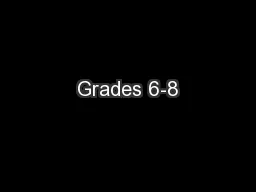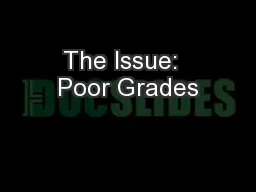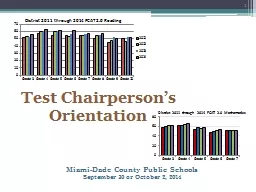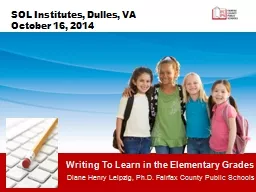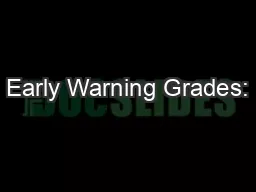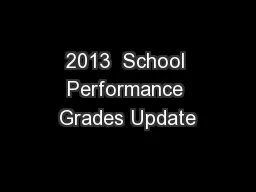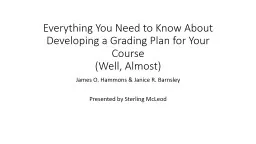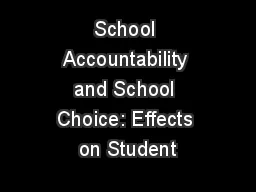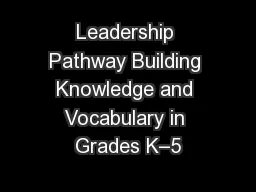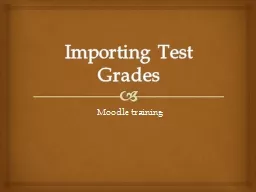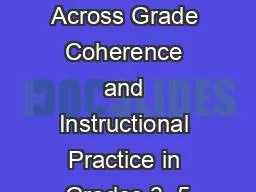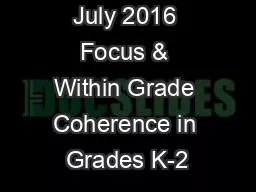PPT-Grades 6-8
Author : pamella-moone | Published Date : 2017-10-16
Implementing a Comprehensive Literacy Framework Module Four Reading LiteratureWriting Narratives Day 1 Objectives E xamine the Comprehensive Literacy Framework
Presentation Embed Code
Download Presentation
Download Presentation The PPT/PDF document "Grades 6-8" is the property of its rightful owner. Permission is granted to download and print the materials on this website for personal, non-commercial use only, and to display it on your personal computer provided you do not modify the materials and that you retain all copyright notices contained in the materials. By downloading content from our website, you accept the terms of this agreement.
Grades 6-8: Transcript
Implementing a Comprehensive Literacy Framework Module Four Reading LiteratureWriting Narratives Day 1 Objectives E xamine the Comprehensive Literacy Framework for Essential Elements amp Coherent Instructional Design. After a twoyear process focused mainly on the issues of afterschool activities and the concerns of parents of younger kids Wilton got its change T he results have been impressive students are getting more sleep and are healthier and happier Profile Where? At P.s. 194M. Presented by: Mrs. O’Brien P.S. 194M jrabt5@optonline.net . How Can We Improve Grades. At P.S. 194m?. How do We Know This is Problem, and Where Can We Get Answers to This Question? . September 30 or October 2, 2014. Test Chairperson’s Orientation. 1. Morning Session. 2014-15 . Testing Calendar. Accountability Update. Test Security, Reporting Violations, and Responding to Inquiries . Diane Henry Leipzig, Ph.D. Fairfax County Public Schools. SOL Institutes, Dulles, VA . October 16, 2014. Objective. Participants will experience the double benefit gained from informal writing activities in elementary content area lessons:. Heeding the Warning. William . Polley. , Ph.D.. Angela Lynn, Ph.D.. Fall 2012 IACRAO Conference. Session 25.25. Early. Warning Grades: . Heeding. the Warning. Institutional Profile. Public, Four-Year University in West Central IL. A-1. Changes for School Grades . for 2012-2013. FCAT Writing Standard raised to 3.5. Inclusion of new standards for Science on grades 5 &. 8. New Achievement levels and inclusion of EOC Assessments . (Well, Almost). James O. Hammons & Janice R. . Barnsley. Presented by . Sterling McLeod. Contributions. Overview of grading approaches. History of grades. Four generic approaches to grading. Provide eight principles . Comments:. Eric . J. . Brunner. University of Connecticut. Overview. In May of 1999, Florida introduced the A+ Accountability . Plan which assigned . letter . grades, . based on student achievement and a set of other factors, to all schools in the state. . Classes Available. . Freshman Year. Apparel Construction and Textiles Levels 1 & 2. Career and Life Planning. Focus on Foods. Classes Available. . Sophomore Year. Child Development. Advanced Foods. my . ar. *e!. A tale of huge investment to raise standards . which proved to be of . little benefit and . what we did next to know how to secure improved student . outcomes: . the macro and micro of evaluating what works.. Winter 2017. Global Neutral . 01001a. Global Warm Neutral. d3d1c8. Global Accent On Dark. ffbf00. Global Accent on Light. ff9800. Global Accent Alt. 97c410. ELA - Coral. ff5147. Math. 009f93. Leadership. Start in Grader report . First. last. ID. Test 1. Rusty. Can. 912345. 82. Rusty. Can. 812345. 95. Jim. Shoe. 712345. 81. Joe . Snow. 612345. 56. Check your Excel sheet. File, Save as. Pick CSV format. 1. ACROSS GRADE COHERENCE IN GRADES 3–5. Welcome Back!. 2. ACROSS GRADE COHERENCE IN GRADES 3–5. Thank You for Your Feedback!. +. . 3. Take responsibility for yourself as a learner.. Honor timeframes (start, end, and activity).. 1. We know from experience the hard work teachers face every day as they strive to help . their. students meet the challenges set by higher standards.. We are a team of current and former classroom teachers, curriculum writers, school leaders and education experts who have worked in the public, private and nonprofit sectors..
Download Document
Here is the link to download the presentation.
"Grades 6-8"The content belongs to its owner. You may download and print it for personal use, without modification, and keep all copyright notices. By downloading, you agree to these terms.
Related Documents

